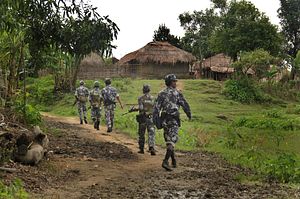On December 15, Myanmar’s air force commemorated its 70th anniversary. The interaction, which featured remarks by the military chief Min Aung Hlaing, put the ongoing modernization of one of Southeast Asia’s largest militaries in the spotlight.
Though Myanmar’s military, known as the Tatmadaw and said to number around 400,000, is technically one of the biggest armed forces in Southeast Asia quantitatively speaking and exercises significant political influence in the country to this day – including under the military-drafted 2008 constitution – its capabilities have also continued to significantly lag some of its neighbors.
But over the past few years, in recognition of this reality, there has also been a clear attempt by the military under Min Aung Hlaing, to further develop and modernize the institution into what he has recently been terming a “standard army,” with a variety of steps including acquiring new weapons, building relationships with foreign militaries, and trying to improve areas like recruitment and training.
While the changing civil-military dynamics created by the election of Myanmar’s first civilian-led government in a half-century, along with ongoing developments such as the treatment of Rohingyas in the country, have no doubt added further uncertainty into a complex, ongoing process that has no shortage of limitations, there is also little to suggest that the overall trajectory of this transformation has fundamentally changed.
The air force has not been immune from the broader changes underway in Myanmar’s military modernization. As I have noted in these pages, over the past few years, several advances have been reached with foreign players, with the list including not just Russia and China, which tend to dominate the headlines, but also India and a number of European countries.
On December 15, Myanmar’s Air Force commemorated its 70th anniversary with a high-profile ceremony at the Air Training School at Meiktila Air Base in Mandalay. The development at the anniversary that made the headlines was Min Aung Hlaing’s commissioning of ten military aircraft in the ceremony as a symbolic indicator of the country’s growing capabilities. Local media reports said the mix of the aircraft for the ceremony included six Russian Yak-130 fighter jets, two Dutch Fokker-70 airliners, two French-Italian ATR 42-430 airliners.
Min Aung Hlaing’s remarks at the ceremony touched on similar key points that addresses of these ilk have in recent years, including the military’s role in forging the country’s independence and preserving the unity and sovereignty of the country thereafter despite internal and external threats to the state, even when the air force was not well developed. He also cast the development of the air force’s capabilities as part of a wider transformation of the military into the so-called “Standard Army,” and noted the importance of air power given the growing prominence of asymmetric warfare and the role of air operations within them.
Beyond Min Aung Hlaing’s role, there were also other ceremonial events were also held as part of the anniversary, Myanmar’s defense ministry said. This included a fly-by demonstration by aircraft and helicopters, honorary awards for pilots, the opening of a commemorative exhibition to mark the anniversary, and other acts such as the release of 70 birds and the sprinkling of aircraft with scented water for blessing.
Much is still unclear about Myanmar’s trajectory of the country’s military modernization, whether it be in terms of the internal dynamics of the military, interactions between the military and other nations, or the relative prioritization of certain forms of military equipment. But the air force anniversary was a reminder of the changes underway and the opportunities and challenges therein.

































